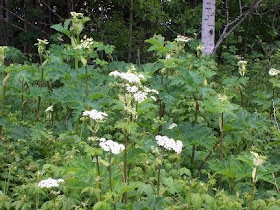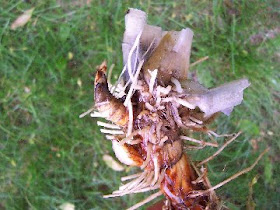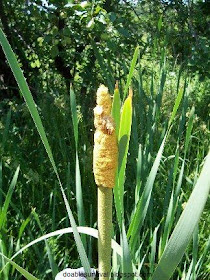Cow Parsnip
(See warnings below.)
This is also known as Indian Celery or Pushki.
I was skeptical about this one, but I was pleasantly surprised and plan to harvest some more of this next spring since I know where to find lots of it. Native Indians used to harvest this plant and use it in many different
ways. It can be used in many different recipes.
Young one coming up in spring.
As with most plants, these are best and most tender before the flowers
open. The young leaves can be eaten raw or cooked, but I think they are best cooked. You will have to try it and see for yourself. The stalks can be
eaten raw or cooked and used the way you would use celery, which has endless
possibilities. The flower buds, before opening, can be eaten boiled. They can be a little strong, so you can change the water a couple of times. Seeds, flower buds, and young leaves can also be dried and used as
seasoning.
Stalk with unopened flowers at the top.
I steamed some unopened flower buds with some young leaves and cut up stalks all together, and they tasted pretty good. I tried the stalk raw also, and I liked that the best. The root is also edible and best from fall to early spring, but many people find it to be too bitter. It was apparently harvested by the Indians quite a bit. I didn't try this part yet. Dried stems can even be used for straws in the
wilderness.
You want to peel the stalks, although very young shoots don't have to be
peeled, specially if you are going to cook them anyway. The stalks for the leaves and
the stalks for the flowers peel a little differently with the skin coming off in
nicer larger pieces for the flower stalks. The stalk that has the leaf on it is
a little sweeter than the flower stalk, and some people dip them in sugar, after
peeling, like some people do with raw rhubarb (like I did when I was a kid). I
tried this, and it was very tasty. I was pleasantly surprised. That was my favorite part, but then I have a sweet tooth. ;)
Leaves, stalks, flower buds.
When I try something new, I like to try it by itself just to get the full
experience of what it tastes like; but this would be very good in different recipes.
Warnings: This plant uses a chemical called furanocoumarin as self-defense
against fungus. The sap and fine hairs on the outside of the plant, if it gets
on you and then is exposed to sunlight, can cause burns and blisters. You want
to use gloves when harvesting it.
I handled some on a cloudy day and then peeled it and cut it up while in the house and then washed my hands and had no problems at all. Some people may be more sensitive to it. Just be careful. :)
I see many warnings about not confusing this with Poison Hemlock; but they look quite different unless you are just looking at the flowers, which you should never do to identify a plant anyway. The leaves are quite different, so you really don't need to worry about confusing them if you know what the leaves look like.
Also, don't get this confused with the Giant Hogweed. This plant is notorious for causing severe burns and blisters. There are a few definite characteristics to go by to tell them apart. Here is a web site that has some nice comparison photos of the two. (click here)
I handled some on a cloudy day and then peeled it and cut it up while in the house and then washed my hands and had no problems at all. Some people may be more sensitive to it. Just be careful. :)
I see many warnings about not confusing this with Poison Hemlock; but they look quite different unless you are just looking at the flowers, which you should never do to identify a plant anyway. The leaves are quite different, so you really don't need to worry about confusing them if you know what the leaves look like.
Also, don't get this confused with the Giant Hogweed. This plant is notorious for causing severe burns and blisters. There are a few definite characteristics to go by to tell them apart. Here is a web site that has some nice comparison photos of the two. (click here)
My Two Cents - I think it's sad how so many people want to just "throw the baby out with
the bath water" and have an all or nothing approach when they find out they have
to be cautious about something instead of just getting educated on it and using
it properly. They love to strike fear in the hearts of people and be dramatic. "Stay away from that plant!" They want to destroy and "eradicate" things or they
don't want anything to do with something that they may have to spend a few
minutes to learn about because they are "too busy" for it. I believe the Cow Parsnip is a very good wild edible to have around,
and I'm glad I know more about it now. :) mooo
Thanks for checking out my blog! :)
Feel free to leave a comment below.
You don't have to sign in.








































